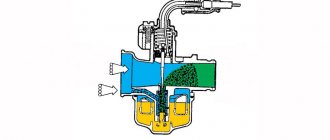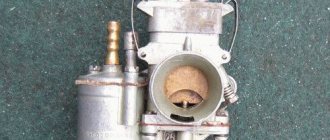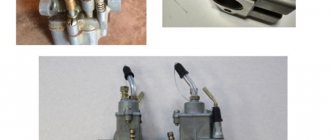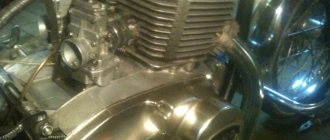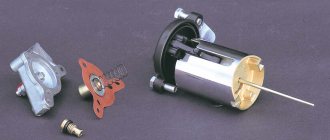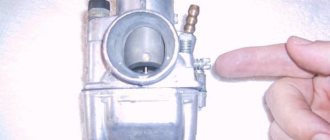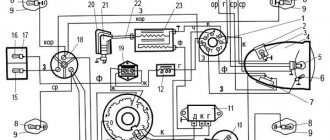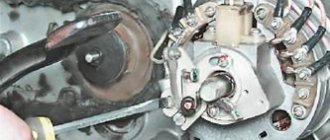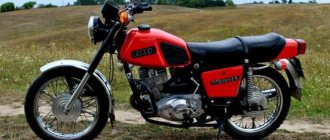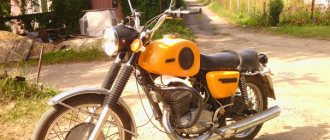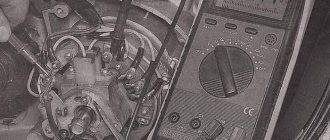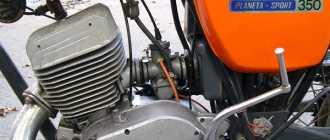Starting system
The 634 model had its own feature - a float quencher.
It served to start the engine in the cold season. The Java 638 does not have such a system, but there is an additional carburetor to start the engine. It is located inside the main one. When starting a cold engine, it makes the fuel mixture more saturated. For it to start its work, a special toggle switch is turned on. After warming up it is turned off. This system only works well when the throttle is lowered, otherwise the starting carburetor will not perform its function. It is important to keep the jet clean. Its close location and pressed fit in the float chamber ensures injection into the diffuser hole
The amount of emulsion supplied depends on the location.
It is important not to forget that adjusting the YAVA 638 carburetor greatly affects the fuel supply and thereby creates the correct air-fuel mixture. In cases where a lack of power is noticeable or popping noises are heard in the exhaust system, it is necessary to adjust the needle valve that injects fuel into the combustion chamber
Which carburetor is better to put on Planet 5 instead of the original one?
If desired, imported Japanese Mikuni carburetors with diffuser diameters of 30 and 32 mm can be installed on Izh Planet-5 motorcycles. Naturally, you need to select jets recommended by the manufacturer. On Planet-5, the throughput of the main fuel jet corresponds to 270 ml/min, the corrector fuel jet is 255 ml/min.
You will also need to select an adapter to connect the carburetor flange to the cylinder. You can order an adapter from a turner or select one from other motorcycle models. The inlet window of the diffuser on Mikuni is wide, so the rubber pipe for connecting to the air filter will also need to be selected.
It is important to remember that all connections must be tight, without distortions.
The diameters of the diffuser and the cylinder inlet must be the same and have no steps that prevent the mixture from entering the combustion chamber.
This is what the installed Mikuni carburetor looks like on the Izh Planet-5 motorcycle.
All of the above also applies to the installation of a Chinese PZ 30 carburetor on the Izh Planet-5 motorcycle. Its special feature is the presence of a version with an accelerator pump, which helps enrich the mixture at high engine speeds. But to use it, you need an additional cable that will work in tandem with the motorcycle’s gas handle.
With minor modifications, the carburetor flange fits well with the mountings to the cylinder pipe. An important point is that you need to install a rubber or textolite gasket between the pipe and the flange so that the carburetor does not heat up when the engine is running.
This is what the installed PZ30 carburetor looks like on the Izh Planet-5 motorcycle.
Imported carburetors are good because they do not have the usual suction. To start the motorcycle, you do not need to fill the crankcase with gasoline; you just need to open the enrichment corrector. These carburetors also have regular drain holes instead of a drain hole, which are fitted with hoses that can be taken out to any convenient place. For example, under a motorcycle engine, so that if the carburetor overflows, nothing will get dirty.
Rework and repair
A significant drawback of the Ikov 2829CE carburetor is poor starting of the motorcycle in cold weather due to the imperfect design of the enricher. Difficult starting is noted not only by the owners of 638 models, but also by the owners of some Kovrov motorcycles on which such carburetors were installed from the factory. The thing is that fuel is taken to enrich the mixture from a separate channel in the float chamber, to which it is connected by a nozzle.
Also, a ventilation duct located on the side of the carburetor is used to draw air to the enricher. The cross-section of this channel is so large that the vacuum in the enricher is not enough to suck fuel through the nozzle. As a result, it is not the enriched mixture that enters the channel behind the throttle, but gasoline vapor mixed with cold air, which of course does not contribute to successful engine starting.
In this case, the vacuum will be sufficient to suck the required amount of fuel from the chamber. You don't have to worry about chamber ventilation, because... On the other side of the carburetor there is the same channel.
Another alternative solution to this problem is to install a float suppressor, as on old carburetors (more details in the photo).
Communities › Kulibin Club › Blog › Attention, motorcyclists! Simple accelerator pump for K-68
Quite a long time ago I decided to install 4 K68 carburetors on my “six”. And all this time I was somewhat saddened by the lack of an accelerator pump on them, and, accordingly, by the failure when the throttle was sharply opened.
When searching on the Internet, only one implemented solution was found - an accelerator pump from a Zhiguli carburetor with a rather complex drive system.
I didn’t want to make such a system at all, so another, very simple solution was found
— to enrich the mixture when the gas suddenly opens, you need to increase the pressure in the float chamber at this moment. On the K-68 this turned out to be very easy to do - you just need to connect the space above the throttle valve with the float chamber. The cylindrical throttle moves tightly in the throttle well and will act as a piston forcing air into the float chamber. And so that when lowering the throttle, a vacuum is not created in the float chamber, you need to add a valve to this entire system that will let air into the space above the throttle when it is lowered.
Such a system is suitable for any carburetor with a cylindrical throttle, for example, a Java Jikov or a moped carburetor.
Now let's talk about how to do this in practice:
In order not to make unnecessary holes, we will blow into the float chamber through the ventilation channel of the float chamber.
The resistance of all channels should be minimal in order to ensure the most rapid increase in pressure in the float chamber, so we pull the fitting out of the channel and drill out the channel to 5mm.
We replace the old fitting with a new one, with a diameter of about the same 5mm.
To make a new fitting, you can take a tube of a suitable diameter from a telescopic antenna. I didn’t have an antenna, so I took a tube from the choke drive rod of the Zhiguli carburetor.
We cut the same fitting into the throttle well cover. The thread on the cap is single start, so every time you screw the cap on it will turn back to where you originally made it.
If the carburetors are new, it is possible that when the cap is screwed on, the sealing ring will be squeezed out. In advance, before cutting into the fitting,
we cut the cap, because the trimmed cap will twist to a different angle, and the fitting will not be where it is needed.
It should not stick out inside the lid, because... This is where the throttle comes out when fully opened, so before gluing it you need to trim it, something like in the photo:
I glued both fittings with thick epoxy glue, something like “cold welding”.
For such a system, a check valve is needed that would create as little resistance as possible. The greater the resistance, the more noticeable the dip will be when closing the damper. Finding such a valve is quite difficult, so we will remake valve 2108-1156010 to our requirements, like this:
Let's disassemble the valve. To do this, we saw off a plastic “donut” from it around the valve itself. It takes up too much space and prevents us from disassembling the valve. I sawed off with a jigsaw, lubricating the file a little with oil, because... This plastic cuts very poorly. If it is possible to use a lathe, it is better to do it with it.
Setting the fuel level in the float chamber of the carburetor Java 638 2928ce
Theory (Java 638 2928CE carburetor adjustment): The float mechanism consists of a double plastic float, a float chamber and a needle valve. In order to correctly adjust the fuel level in the float chamber, the carburetor is disconnected from the engine and the bottom cover is removed from the carb. The level must be set at a distance of 11 mm from the plane of the connector between the carburetor body itself and the plastic float chamber.
Solution (Java 638 2928CE carburetor adjustment): place the body with floats on the edge of a half-liter glass jar and connect it to the fuel tank with a thin hose.
Open the tank tap and wait for the fuel level to settle. Considering that the height of the collar at the bottom of the body is 2 mm, it should be 9 mm from the top edge of the can.
If the level does not work out this way, then you need to bend the tongue between the floats until the level is 9 mm from the edges of the can
Carburetor idle adjustment Java 638 2928ce
First, using the spool stop, we set the minimum stable speed (screw_1) (for a run-in engine this is 600-1000 rpm). Then, by rotating the quality screw (screw_2), we look for the position at which the speed will be maximum. This is done slowly. Each time the screw must be turned no more than 1/4 turn and wait a while until the rotation speed stabilizes. Of course, we determine the speed using the standard tachometer. Keep in mind that unscrewing the quality screw (screw_2) more than two turns is ineffective; with further unscrewing, there will be practically no depletion. After the position of the highest speed is found, lower the spool slightly until the speed drops to the previously set one. Then you can try to increase the speed with the quality screw, that is, clarify the position of the quality screw. Adjustment of the Java carburetor is carried out only on a warm engine.
Adjusting the mixture quality of the carburetor Java 638 2928ce
The composition of the mixture at full and medium lift of the spool can be influenced in two ways - by changing the size of the main jet or the position of the needle. Moreover, the size of the nozzle has a greater impact on the composition of the mixture when the diffuser is fully open (raising the spool), and the position of the needle affects mainly at medium. Since when the spool is not fully raised, maximum power from the engine is not required, but efficiency is important, it is necessary that the mixture be lean. But excessive leaning will cause a “failure” in the engine’s operation at partial throttle opening modes. Therefore, it is necessary to choose a needle position such that the mixture is lean, and the engine operation remains stable in all modes, without “failures”. Lowering the needle (moving its latch upward) causes depletion, and raising it causes enrichment. Usually, after running in, the needle is lowered, moving the latch up one notch
However, it will be better if, when adjusting the carburetor in Java, moving the needle, you pay attention to the operation of the engine before and after the change, try different positions of the needle. It is advisable to make a selection, since this affects both the quality of engine operation and the overall fuel consumption of the motorcycle
Designations in the figure: 1 cylindrical spool; 2 needle valve; 3 idle jet; 4 additional system jets; 5 main jet; 6 spool needle; 7 needle guard.
The Java-638-5 carburetors have a main jet of size 90, and on the Java-638-0 it is increased to size 92.
JAVA-638-5 produced in 1984 - 1985, the starting nozzle was size 72, i.e. diameter 0.72 mm. In the new carburetor, the size of the starting jet was increased to 85 mm. There were practically no problems with launching the YaBE-638-0 at temperatures down to -10° C.
- Main jet – 92
- Additional system jet – 72
- Air the jet will be supplemented, systems – 120
- Economizer jet – 50
- Starting jet – 85
- Idle jet - 40
- Idle output jet – 80
1 – spool assembly; 2 – needle valve assembly (Ø2 mm); 3 – idle jet (40); 4 – additional system jet (72); 5 – main jet (92); 6 – spool needle; 7 – needle lock.
When the diffuser is fully opened, maximum power is needed, so the mixture must be enriched.
Motorcyclists who demand power can, in addition to the basic adjustment of the JAVA 638 2928CE carburetor, do an additional adjustment - selecting the main jet.
note
It is usually made from a standard one, increasing the cross-section using a homemade triangular reamer from an ordinary sewing needle treated with emery. It is best to flush the carburetor with clean gasoline. The jets can be cleaned using a pointed match or a soft copper wire.
Carburetor Jikov 2928 CE-Cleaning and adjustment
Jikov carburetors produced in the Czech Republic (for cars and motorcycles) are often used on motorcycles of the Kovrov plant named after Degtyarev - ZiD. These devices provide efficient preparation and delivery of the fuel mixture to the engine - provided they are properly configured and adjusted. The Jikov carburetor is equipped with several complex fuel supply/dosing systems and its emulsification (crushing and spraying).
The composition of the fuel mixture is maintained as optimal as possible for each engine operating mode - as much as possible at all with a given fuel system design.
It should be remembered that the spread of fuel concentration in the air-fuel mixture is not that great - from 1/15 on average to 1/10 with a rich mixture and 1/20 with a lean mixture. When the mixture goes beyond these limits, it stops igniting. However, if the carburetor is damaged or adjusted incorrectly, mixture formation may go beyond these limits.
To set up all carburetor systems for proper operation, it is advisable to adhere to a certain procedure. This procedure is described below along with explanations of the operation of the subsystems.
Warning! The work being carried out is flammable! Using open fire, electric lamps, smoking yourself and allowing smokers into the room is unwise and very dangerous!
1. Inspection and preparation of the motorcycle fuel system. — From top to bottom, starting from the gas tank cap and ending with the air filter. Here are the main points: All parts of the system, inside and out, must be clean. The hole - the breather in the tank lid - is not clogged. The tank inside is not rusty (at least not very rusty). The gas tap is clean inside, with a whole mesh filter, without surface corrosion. Fuel hoses are tightly seated on the fittings. The additional fuel filter - if present - must be installed correctly, in the direction of the arrow on its housing. There have been cases when an incorrectly installed filter was turned over after some time and installed again. Of course, all the accumulated dirt went into the carburetor. Further. Gaskets, flanges and carburetor pipes must sit tightly in place, without distortions or cracks. Homemade gaskets should be cut smoothly, neatly and not protrude inward. The air ducts should have clamps - often the rubber pipes are held loosely, and when they vibrate, they “suck in” dust and dirt. The air filter and receiver box must be in perfect order, cleaned and processed according to the instructions. Finally, the throttle cable - the throttle cable - must be washed with gasoline and lubricated with either liquid oil or a special product for sheathed cables. The cable sheath, of course, should not have any creases or stretched areas.
2. The carburetor should be removed from the motorcycle. First, do not forget to thoroughly wipe the outer parts of the engine and the carburetor itself with a rag. Cleanliness will not be superfluous in such a serious matter. The top cover must be unscrewed to remove the cable. Move the removed carburetor - possibly with fuel residues - to a clean, bright room. Removing the remaining fuel is easy - by removing the float chamber (bottom) - but remember that small parts can easily get lost! Immediately remove the float shaft, float, and stop valve. Please note: some carburetors have a miniature plastic O-ring on the valve cone - don't lose it! And one more thing: when removing the float chamber and shaking out the remaining gasoline, carefully inspect it for sediment, water emulsion, rust, metal particles, sand and dirt... Prepare clean dishes, calico (lint-free) napkins, a thin hard brush, screwdrivers and other tool. The instrument must be clean and dry in advance. Of the flushing fluids, naturally, you will need some gasoline without oil, or even better - nefras B40, B70, S2-80/120 (Galosha gasoline). What's better? - because it dries quickly and without leaving a trace, leaving no odor.
3. Disassemble the carburetor as much as its condition requires and your skill allows. Inspect the surfaces of the parts (if there is loose corrosion that needs to be cleaned off), unscrew and remove the jets, emulsion and supply tubes one by one, inspect and clean them. Write down where each jet is located and what numbers are stamped on them! This will also come in handy when talking about your carburetor in the future.
The channels where the jets were must be carefully inspected and cleaned.
Turn out the adjusting screws, remembering where each one was, and clean the opened cavities and channels.
Note. When cleaning, be careful not to damage the nozzle holes! Use fishing line, a pointed match, or copper wire for cleaning. Tarred surfaces can be cleaned with acetone, solvent, butyl acetate - but do not allow these liquids to come into contact with floats, plastic and painted parts.
4. Assembly, checking and initial adjustment. Rinse the body clean in nefras, wipe it, blow out the channels and - collect! Replace all parts except the top cover and float chamber. Now check the fuel level maintained in the chamber. This is done like this:
A gas line is connected to the carburetor, at the upper end of which an improvised funnel (for example, a piece of plastic bottle) is attached. The carburetor itself is placed evenly on top of the glass jar so that nothing prevents the float from moving. Add fuel into the funnel (here it is more correct to use regular fuel or gasoline) until it fills the bottom jar and raises the float. The float will close (I hope you didn't forget to replace the valve?) the fuel supply. Mark (draw a line with a felt-tip pen) the fuel level on the can, and carefully remove the funnel to a safe position. Use a ruler to measure the fuel level, it must comply with the instructions (for the Jikov 2928 CE carburetor of the Zid-200 “Courier” motorcycle = 9 +/- 1 mm from the side of the carburetor body). You can correct the level by slightly bending the valve lifting foot and repeating the experiment.
(The most cunning motorists stick a label with level marks on the jar in advance, or simply make the necessary marks on it.)
When finished, replace the float chamber housing.
Note and write down how the main fuel system needle lock is installed - on which groove. You may have to change this setting later.
Finally: measure how many millimeters the main throttle valve is raised when the quantity screw is screwed in all the way. Note how many turns of the adjusting screw to the left you need to make so that the clearance to the throttle edge is 3 mm and 2 mm. Write this down - it will come in handy later! Leave a gap of about three millimeters for now.
(As you might guess, the notes made often end up unknown where exactly at the most necessary moments. Therefore, it’s a good idea to write down the main numbers, even just scratch them, right on the carburetor body.)
5. Assembly and adjustment on the engine. Testing on the go.
A feature of Jikov carburetors, unlike many others, is a greater distinction between the idle, idle and cruising mode systems. So, the instructions for setting up these carburetors say: adjusting the composition of the fuel mixture to reduce the “dip” of power when the “gas” is sharply opened is carried out by REMOVING the throttle needle of the main fuel system. For carburetors of the K65K type, this is done with the “quality screw” of the idle speed. Please note this difference. Adjusting the idle system consists, firstly, of setting the optimal degree of enrichment of the mixture - for a confident start and movement with minimal gas. Secondly, by sequentially adjusting the “quality” and “quantity” screws, the best conditions for the operation of the idle system itself are achieved - this means, first of all, working with a minimum rise of the main throttle valve. It is at low lift that the pressure difference in the fuel and air passages of the carburetor allows the idle system to operate effectively. Follow the factory instructions: Unscrew the quality screw 1.5 turns from the stop. Start and warm up the engine - a little at first, a couple of minutes - after all, you have not yet adjusted the carburetor and there may be unpleasant splashing of the spark plug with the fuel mixture. Using the quality screw, slowly “grope” for the limits of its installation, within which the engine does not stall. Leave the screw in the highest engine speed position - the mixture composition is now close to optimal. Further. It is necessary to shift the work of mixture formation to an even greater extent onto the idle system. To do this, gradually turn the quantity screw to the left, the throttle valve will lower. When the engine speed decreases, adjust the mixture composition with the quality screw - the engine speed should increase as much as possible. And turn the quantity screw to the left again, reducing the speed. Stop there. Give the engine gas once or twice, turn off the ignition. Take a break for a few minutes. Start the engine again when it is still warm, do a test drive - try driving at medium and full throttle for several kilometers. Thus, you will warm up and clean the spark plug, and test all engine systems. In cruising mode, the fuel mixture cannot be excessively rich or lean - the engine should operate more or less normally at any settings. Take note to see if there are any interruptions or misfires (the mixture is rich), how big the “failure” is when you suddenly add gas. This “dip” in traction cannot be completely eliminated, unfortunately - we don’t have an automobile boosting subsystem... However, it can be smoothed out by slightly enriching the mixture by raising the main throttle needle by one or two grooves (the needle lock-lock can be easily rearranged - but do not lose it when this!). You will do this sometime later... After test rides (I guess there will be more than one ride - after all, a motorcyclist loves to ride) try to unscrew the quantity screw a little more and adjust the engine mode with the quality screw. The general principle is this: the lower the throttle valve is set, the less the idle and cruising systems influence each other, while working with high efficiency and ensuring reliable starting and good engine performance. The author on the ZID-200 “Courier” motorcycle has a throttle clearance of 2 mm. There is information about reducing this gap down to 1 mm (https://zid200.org.ru/forum/main.php), and according to other sources - up to 0.5 mm. In the future (anything can happen), situations may arise when you want to “raise” the idle speed. For example, the engine stalls when stopping at a traffic light. Of course, this is the simplest and most reasonable solution. But still remember: large throttle clearance is a big problem. (By the way, not everyone knows: when stopped at a traffic light or in a similar situation, you should NOT engage neutral gear! Stand with the clutch depressed in first gear. In general, develop automaticity in yourself - engage the appropriate gear for a given speed in a timely manner, despite the clutch being depressed. For example , when reducing speed to stop, switch to 3-2-1 without waiting for a complete stop.) About the starting device. You can use it, but know that the engine starts just fine without it! And most importantly, when driving, do not forget to turn it off, otherwise the spark plug will quickly become smoked and filled with fuel.
When talking about carburetor tuning, we can’t do without talking about the spark plug. Some materials on this topic are being prepared.
6. Checking the serviceability and degree of wear of carburetor parts and assemblies (materials are being prepared)
7. Typos noted in the factory instructions for the “Courier” motorcycle: page 7, third line from the bottom - should be “When starting a warm engine, DO NOT press the float stopper and do not use the starting device...”
In conclusion, the author considers it his duty to express gratitude to the authors of books on motorcycle technology: K.I. Dementyev, N.N. Yumashev, V.A. Alekseenko, F.M. Mamaev, L.E. Bratkovsky, B.F. Demchenko and many others, as well as participants in the discussion on the topic on the Internet forum https://zid200.org.ru and senior comrades (motorcyclists and not only).
Author: Lashmanov A.E.
Site search:
What did they put on the motorcycles from the factory?
A distinctive feature of all Czechoslovak carburetors is the cylindrical shape of the throttle valve. It is driven by a mechanical cable drive, which determines their belonging to slide carburetors.
There are numerical and alphabetic indices on the case, which are deciphered as follows:
- the first two digits (29) – carburetor with throttle valve (with variable vacuum);
- 26 (24.28) – diffuser diameter;
- SD - carburetor with a starting device and a main fuel jet located under the nozzle;
- SBD – carburetor without starting enrichment. The main fuel jet is located under the nozzle.
Types of BSZ
— Single-channel (one Hall sensor, two-lobe modulator, one switch, one two-terminal ignition coil operating on two cylinders at once)
— Two-channel (two Hall sensors, one, or better yet two, modulator lobe, two switches, two ignition coils, one for each cylinder)
It is preferable to install a single-channel system, since it will be more stable, because here you won’t have to adjust each cylinder (which you have to do at KSZ); here, if the modulator is made correctly, then only one cylinder is adjusted
Also, in a single-channel one, fewer wires are used, its parts take up less space, and energy consumption is lower (which is very important for 6-volt generators). There are many people who like to “get confused” who install a two-channel one, shouting at the same time that this way they can configure it more accurately, etc.
I assure you that these are unnecessary hassles, and there will be no accuracy here (why is indicated above)
There are many people who like to “get confused” who install a two-channel one, shouting at the same time that this way they can configure it more accurately, etc. I assure you that these are unnecessary hassles, and there will be no accuracy here (why is indicated above)
Spark plug. I said above that spark plugs “live” longer, which begs the question “Why?”
Actually the answer is simple. If you decide to install a single-channel BSZ (or a two-channel one with a two-lobe modulator), then this is what will happen:
When igniting in one cylinder, in the other, a spark will also strike at BDC, since it strikes simultaneously on both spark plugs, that is, spark twice per revolution on each spark plug.
Carburetor of Izh Planeta 3.4 motorcycles
Izh Planet-3 motorcycles were equipped with K-62P and K-36I carburetors. The latter had a unique design for its time. The throttle shape was U-shaped, which made it possible to significantly reduce the dimensions of the carburetor (in comparison with the K-28 and K-37 produced at that time). The corrector was moved out of the diffuser area and regulated not the air, but the fuel. This solution made it possible to reduce fuel consumption by 4-6% due to more stable mixture adjustment.
The mixing chamber cover was fastened with special locking springs, which made it possible to quickly and conveniently replace the throttle cable or rearrange the needle. The main fuel jet was screwed into the bottom of the carburetor next to the drain plug. To clean it, it was not necessary to dismantle the carburetor. The diameter of the diffuser of the K-36I carburetor at the outlet is 28 mm, and in the middle it is 26 mm. That is, the mixing chamber is a kind of aerodynamic profile, which has a beneficial effect on mixture formation.
Another feature of the K-36 carburetor is its operating principle, which is similar to a car carburetor. The screw for the amount of mixture in it regulates not the air, but the fuel emulsion entering behind the throttle. Due to this, the sensitivity of the carburetor settings at idle has increased. Adjustment is carried out with screw 1 for the quantity of the mixture (at an angle) and screw 2 for the quality.
The K-36 carburetor has one drawback. It is sensitive to road dust. The upper latches do not seal the lid of the mixing chamber tightly and dust particles get there, the valve begins to jam and wear out. That is why motorcycles on which such carburetors were installed (Kovrovets, Izh Planeta-3, etc.) were equipped with carburetor protective covers.
Later, new K-62 carburetors with the indices I, P, B began to be installed on the Izh Planet-3, 3-01 and 4 motorcycles. The power of two-stroke engines grew and there was a need to increase the diameter of the diffuser (now it was 32 mm), throughput jets, etc.
The new carburetor design made it possible to uninterruptedly supply the engine during sudden braking and acceleration, tilting and rolling of the motorcycle.
Setting up such a carburetor is carried out similarly to the K-68 setting described above. The quantity screw is not located on the side of the carburetor, but in the upper part.
We install the ignition from the scooter to Java
First of all, we check whether our adapter plate is suitable, if so, then we attach it, install the rotor and stator. The latter should fit completely into the rotor; for convenience, we adjust the distance with washers. We install the sensor and make sure that everything rotates with a reserve and does not touch anything.
Now we need to modify the rotor. From the existing mark on the rotor, after 180 degrees we install a new mark. To maintain the accuracy of the procedure, it is best to use special devices that measure the angle of rotation; you can also use a lathe for this. We solder or weld the mark, obtaining 100% reliability of the unit.
ADJUSTING THE QUALITY OF THE MIXTURE OF THE CARBURETOR JAVA 638 2928CE
The composition of the mixture at full and medium lift of the spool can be influenced in two ways - by changing the size of the main jet or the position of the needle. Moreover, the size of the nozzle has a greater impact on the composition of the mixture when the diffuser is fully open (raising the spool), and the position of the needle affects mainly at medium. Since when the spool is not fully raised, maximum power from the engine is not required, but efficiency is important, it is necessary that the mixture be lean. But excessive leaning will cause a “failure” in the engine’s operation at partial throttle opening modes. Therefore, it is necessary to choose a needle position such that the mixture is lean, and the engine operation remains stable in all modes, without “failures”. Lowering the needle (moving its latch upward) causes depletion, and raising it causes enrichment. Usually, after running in, the needle is lowered, moving the latch up one notch
However, it will be better if, when adjusting the carburetor in Java, moving the needle, you pay attention to the operation of the engine before and after the change, try different positions of the needle. It is advisable to make a selection, since this affects both the quality of engine operation and the overall fuel consumption of the motorcycle
Designations in the figure: 1 cylindrical spool; 2 needle valve; 3 idle jet; 4 additional system jets; 5 main jet; 6 spool needle; 7 needle guard.
How to install and adjust the carburetor on Izh Jupiter 5
Jupiter 5 is one of the most successful creations of Soviet motorcycle production.
Today, like 30 years ago, the device is often found on the streets of both remote outbacks and large cities, and, in most cases, the owner prefers to handle its maintenance independently. The carburetor, being one of the most important components of any motor vehicle, is subject to intensive use and increased wear. Considering the great age of some models, replacing this module very often becomes an inevitable condition for extending the life of the unit.
The motorcycle is equipped with Izhevsk carburetors K-62D, K-65D, K-68D , or the Czechoslovak model Jikov-2928SE . There are few differences between the first two options: the design of the top cover; enrichment jet diameter; needle fastening (K-65D comes with a nozzle). The K-68D differs from its predecessor:
- Enlarged diffuser.
- A round (not square, like the K-65) damper.
- Lateral (more convenient for optimization) location of the idle screw.
- Threaded (for quick needle adjustment) top cover.
Which carburetor is better to install on IZ Jupiter 5? As you can see, the 68th model is more convenient to maintain , however, experienced motorcyclists note that it often contains defects, for example, in the form of the absence of a hole that improves the formation of the fuel mixture.
Jikov-2928CE is considered a higher quality carburetor, but also more difficult to operate and repair. Therefore, when choosing this option, you should prepare for possible difficulties, for example, when searching for replacement jets, because their size is much smaller than those from Izhevsk.
Rice. Carburetor K-62:
1 — idle fuel jet, 2 — main fuel jet; 3 — float chamber, 4 — sprayer; 5 — float axis, 6 — float lever bushing; 7 — air channel, 8 — nozzle, 9 — dosing needle, 10 — body; 11 — throttle, 12 — needle lock; 13 — throttle spring; 14 — throttle lift limiter (removed after engine break-in); 15 — throttle control cable, 16 — rod with idle speed adjustment screw (lowering the throttle); 17 - cover; 18 — idle speed adjusting screw, 19 — fuel inlet fitting, 20 — adapter hole, 21 — idle speed emulsion channel; 22 — drainage hole, 23 — idle air channel, 24 — locking needle with washer, 25 — float, 26 — corrector emulsion channel; 27 — dosing needle; 28 — float stopper, 29 — plunger, 30 — plunger spring, 31 — corrector control cable
The design and jets of the carburetor Java 350 638 2928 CE
The Java-638-5 carburetors have a main jet of size 90, and on the Java-638-0 it is increased to size 92.
JAVA-638-5 produced in 1984 - 1985, the starting nozzle was size 72, i.e. diameter 0.72 mm. In the new carburetor, the size of the starting jet was increased to 85 mm. There were practically no problems with launching the YaBE-638-0 at temperatures down to -10° C.
Sectional view of Java 350 carburetor
- Main jet – 92
- Additional system jet – 72
- Air the jet will be supplemented, systems – 120
- Economizer jet – 50
- Starting jet – 85
- Idle jet - 40
- Idle output jet – 80
1 – spool assembly; 2 – needle valve assembly (Ø2 mm); 3 – idle jet (40); 4 – additional system jet (72); 5 – main jet (92); 6 – spool needle; 7 – needle lock.
When the diffuser is fully opened, maximum power is needed, so the mixture must be enriched. Motorcyclists demanding power can, in addition to the basic adjustment of the JAVA 638 2928CE carburetor, do an additional adjustment - selecting the main jet. It is usually made from a standard one, increasing the cross-section using a homemade triangular reamer from an ordinary sewing needle treated with emery. It is best to flush the carburetor with clean gasoline. The jets can be cleaned using a pointed match or a soft copper wire.
How to install a carburetor
Before installing the carburetor on IZ Jupiter 5, make sure it is completely clean and all parts are present. First, remove the carburetor cover with the three-hole throttle body. The round hole located in the center is intended for placing and fixing the needle, the shaped one, located on the side of the cutout, is for attaching the cable coming from the throttle handle, the T-shaped one is for installing the screw rod. The new carburetor on the IZH Jupiter 5 has a limiter located in the cover, which is removed after the break-in period.
After fixing the carburetor to the engine, a cable is attached to the shaped hole of the throttle and the cover is tightened. The throttle is checked for the ability to fully open the diffuser and not jam in all positions of the throttle stick.
Next, the fuel line is connected to the fitting. The joints are checked for the slightest leak, after which the starting device is opened.
Apply a few light presses on the claw, then start the engine normally. After checking the functionality of the device and the uniformity of fuel distribution on a warm engine, the ignition can be turned off.
What will you need?
To install the ignition from a scooter in Java, we will need a specific conversion kit. First of all, there is the generator itself; there are two models to choose from. The simpler QMB-139 will perform all the necessary functions, but problems may arise with the light at night, since the winding for the head light is rather weak and will greatly depend on the speed. If this parameter is important to you, then choose a stator from the QMI-157 or 152QMI model - they will be sufficient to achieve your goals.
You will also need an ignition coil with two terminals, here again there is plenty to choose from. For our purposes, motor coils ZMZ-406 or from Oka are suitable.
You will need a 12 volt battery. We don't need a new one; any used motorcycle or new Chinese battery will do. Its role is to smooth out voltage drops in the turn signal and stop signal circuits.
Also, do not forget about the set of wires/terminals. It is better to take the latter from Japanese scooters.
The last item is the adapter plate. Alas, it cannot be found on sale, but kind people have prepared the exact drawings presented below, according to which you can assemble your own adapter plate or order it. The thickness of the metal is 4 mm, this is an important parameter, because if you make the plate larger or smaller, some elements of the system may not fit or work incorrectly.
Main dosing system
When the throttle rises to a height of five millimeters, the main dosing system is activated. Here a complete mixture is created for enhanced engine performance. However, before creating the mixture, the fuel passes through an annular channel. A small amount of air gets into it there. After entering the diffuser, the fuel is enriched with air from the main flow.
The quality of the mixture can be influenced by changing the angle of the injection needle or the size of the main hole. In this case, the hole plays the main role of enriching the mixture when the throttle is raised, while the needle only plays a role in the middle position. When the diffuser is fully open, maximum output must be achieved. This can be achieved with a higher quality of the combustible mixture. In this case, you can select the jet of the required size and install it. Usually the new jet is a standard one, in which the hole is enlarged.
Synchronizing carburetors on a motorcycle
Synchronizing motorcycle carburetors is a precise procedure, but not very difficult. To carry out this action you will need a synchronizer. This is a set of meters that check for sparsity. And the meter itself is a vacuum sensor with a valve that smoothes out the oscillations of the needle. Sets with two or four heads are used. A four-head device is best.
Synchronization procedure:
- The motorcycle warms up to the required temperature.
- The tank is removed, then the filter.
- Now you need to choose the places where to connect the device heads. What is the essence of synchronization? It is necessary to set the same rarefaction formed in the collector. Because through it the combustible mixture enters the inlet cylinders from the carburetor. Therefore, connection points must be selected in the collectors.
- The device connects to the found collection points. It happens that it is difficult to get to these points, and then the carburetors can be raised. To do this, they are pulled out of the pipes, and after connecting the device, they are seated in place.
- The motorcycle starts. The valves of all sensors need to be adjusted. It is necessary that they react to any changes in sparseness, but do not fluctuate much. The valve is released if the arrow does not respond to any changes.
- Three screws can be seen on the carburetor. It is with their help that synchronization is carried out. One of them, the first, is located between the first two carburetors. We synchronize them. To synchronize the second pair of carburetors, the third and fourth, a third screw is used. He is between them. The central screw synchronizes all carburetors with each other.
- The first pair of carburetors is synchronized.
- The second pair of carburetors is synchronized.
- All readings are now aligned using the center screw.
- After the synchronization is completed, we apply gas, sharply raise the speed and reset again. All readings are synchronous.
- If this is not the case, the procedure, starting from the seventh step, must be repeated.
You can change the oil or carry out the synchronization procedure yourself. But adjusting a motorcycle carburetor is the more difficult part of the repair. And if you don’t have the skills to do this kind of work, it’s best to turn to professionals.
Econostat
The econostat is a system that enriches the mixture at a high throttle position. Its device is very simple. The essence of the work is to take fuel from the float chamber with a pipe. Through the channels, the fuel rises into the diffuser and is sprayed in front of the throttle. This helps air bypass the throttle when it opens low.
In conclusion, we note that after each work carried out, adjusting the YAVA 638 carburetor is very important, see the video about which at the end of the article. It is also necessary to carry out timely maintenance of the carburetor, the essence of which is to clean the main working elements. Washing should be done as often as possible, preferably with diesel fuel or gasoline. It is better to treat resinous areas with caustic substances, for example, acetone. Otherwise, the system will not cause you problems.
For Java 638, a new type of carburetor was created in order to increase engine power. The diffuser diameter was increased to 28 mm (previously 26); introduced additional systems and complications. The only element left from the previous carburetor is a cylindrical spool, which, in comparison with Soviet K-62 carburetors, ensures uniform and fine atomization of the mixture. The carburetor is attached to the engine through an insert ring made of gasoline- and oil-resistant rubber. By turning the carb 90 degrees, it is very easy to remove the cover, move the needle to a different position, clean the jets and float chamber. (See continuation)
Carburetor repair
When using the motorcycle for a long time, you may encounter carburetor overflow (leakage from the drain hole). First of all, it is recommended to check the fuel level in the carburetor and the tight fit of the shut-off needle. By bending the locking needle brackets in the desired direction, we adjust the fuel level (the distance from the plane of the middle of the floats to the edge of the carburetor body is 13±1.5 mm). The tapered end of the locking needle is made of rubber. If it becomes leaky, it is recommended to replace it with a new needle from the repair kit. It also happens that the floats begin to leak gasoline due to fatigue of the material. It can also be treated by replacement.
Floats
Fuel nozzles become clogged due to low-quality fuel or when dirt gets in from the air through the filter. To clean gasoline, in addition to the mesh in the fuel tap, you need to additionally cut the fuel filter into the gas hose. The air filter must be tightly connected to the carburetor. At the same time, you cannot change its design, much less install a so-called zero.
The filter element must strictly comply with the throughput recommended by the motorcycle manufacturer. Never use needles or wire to clean the jets. It is enough to wash them in gasoline and blow them with compressed air.
Carburetor K-62 disassembled.
Sometimes it happens that when starting or running a motorcycle, the carburetor sneezes. This happens due to problems in the ignition system. The first step is to replace the spark plug. If this does not help, then the ignition has failed. Usually the carburetor shoots during early ignition. Sneezing can also be caused by a mixture that is too lean. The combustion process of such a mixture is slow and when the piston opens the inlet window, the mixture shoots into the diffuser.
The main reason for a lean mixture is air leaks in the following places:
- from under the crankshaft oil seals;
- cylinder heads;
- at the junction of the carburetor flange and the cylinder pipe.
We try to find and eliminate the cause of air leaks using the elimination method. You should start with inspecting and adjusting the ignition system.
Java motorcycle carburetor
Java 638 motorcycles use a Jikov-2928 CE carburetor. The carburetor consists of the following main parts. Float mechanism with float chamber, double plastic float and needle valve.
The fuel level is checked with the carburetor removed and should be 11 millimeters from the joint surface of the carburetor body and the float chamber. To check, pour gasoline into a regular glass jar, leaving 15-20 millimeters short of the brim.
Next, place the motorcycle carburetor on top of the can, connect the gas tank to the carburetor, and open the tap. We wait for the flow of gasoline to stop and measure the distance from the edge of the can.
The Java 638 motorcycle often gets clogged in the carburetor, and even the fine fuel filter, which can be installed by cutting the gas line and inserting it in the middle, does not help.
A filter for a Java motorcycle can be installed, for example, from a Zhiguli car. To clean the carburetor without removing it from the motorcycle, you need to close the tap while continuing to move and open it when the engine does not have enough fuel and it starts to fail.
Important
The flow of gasoline should wash away the speck and normal carburetor operation will be restored.
The carburetor does not have a float suppressor, as on the Java 634 motorcycle. Instead, there is a lever that rises up when starting a cold engine, which is much more convenient. There are no problems with starting up to minus 5-10 degrees. There is another way to enrich the fuel mixture - you need to cover the drainage hole with your hand, located near the starting device under the lever.
Float mechanism and starting device: 1 - enrichment nozzle 2 - float chamber 3 - enrichment 4 - enrichment lever 5 - fitting 6 - float 7 - needle valve.
When the throttle opening is small (about 0.5 mm), the idle mechanism operates. On a Java 350 motorcycle, it consists of a size 40 jet, an idle speed adjustment screw, emulsion tubes and channels.
The idle speed is adjusted as follows: warm up the engine, use the spool stop screw to set the engine speed to 800 -1000 rpm. Then, slowly turning the quality screw, we find the position where the engine speed will be maximum.
Each time the screw must be turned no more than ? revolutions and wait until the engine speed is established. We control all this using the tachometer. When the maximum position is found, we lower the spool with the screw until the revolutions return to their previous value.
Then, using the quality screw, you can once again try to raise the speed, thereby clarifying the adjustment.
Idle system: 2 - emulsion tube 4 - additional emulsion tube 5 - throttle lift screw 6 - carburetor body 7 - quality screw.
To prevent a “failure” in the Java motorcycle carburetor when the throttle is lifted slightly, a transition system is provided. It has air and fuel jets. The air to the transition and idle systems comes from a single channel, then part of it goes to the idle system, and part of it goes through the air nozzle to the additional system.
Main dosing system and econostat: 1 - main jet 2 - needle 3 - spool 4 - spring 5 - cover 6 - econostat 7 - econostat jet
The main metering system of the Java motorcycle begins to work when the throttle is raised more than 6 millimeters. The composition of the mixture at medium and full throttle opening is affected by the size of the jet and the position of the needle.
When the engine is not fully opened, the efficiency of the engine is more important than its power, so the mixture should be lean, but not excessively, otherwise there will be interruptions at small openings. This is regulated by moving the needle; when lowering, the mixture becomes leaner; when raising, it becomes richer.
Experiment with the position of the needle and find the position that suits you best.
Unlike the carburetor of the Java 634 motorcycle, the carburetor on the Java 638 motorcycle is equipped with an econostat that operates at large diffuser openings (more than 14 mm). The ecostat enriches the fuel mixture, increasing engine power.
Fuel is taken through a tube from the float chamber and then rises through channels above the diffuser and is injected in front of the spool.
The Java econostat atomizer is located in the upper part of the diffuser, so with small openings it practically does not work.
Motorcycle exhaust system - what is it?
Spark plugs for motorcycle
Motorcycle exhaust systems
This entry was posted in Engine. Bookmark the permalink.
Carburetor adjustment Izh Jupiter 5
Adjusting the IZ Jupiter 5 carburetor is the simplest, but at the same time the most important process. Whether it is K-62, K-65 or K-68, you must first warm up the engine to operating temperature, and then perform a sequential series of actions :
- Set low but fairly stable engine speeds by rotating the screw that adjusts the throttle position.
- By changing the position of the idle screw, set the engine to maximum speed.
- Repeat these steps 4-5 times, gradually reducing engine speed.
- Check with sharp jerks that the adjustment is correct.
The carburetor on the IZ Jupiter 5 should be adjusted so that there are no jerks and the engine does not stall in the event of sudden opening and closing of the throttle. In the first case, you should enrich the fuel mixture by turning the idle speed screw ¼-½ turn clockwise. In the second, turn the screw in the opposite direction.
You can also adjust the carburetor on IZ Jupiter 5 in operating modes. Depending on weather conditions and the technical condition of the engine, the metering needle can be moved up to enrich the mixture and down to obtain the opposite effect.
SETTING THE FUEL LEVEL IN THE FLOAT CHAMBER OF THE JAVA 638 2928CE CARBURETOR
Theory (Java 638 2928CE carburetor adjustment): The float mechanism consists of a double plastic float, a float chamber and a needle valve. In order to correctly adjust the fuel level in the float chamber, the carburetor is disconnected from the engine and the bottom cover is removed from the carb. The level must be set at a distance of 11 mm from the plane of the connector between the carburetor body itself and the plastic float chamber.
Solution (Java 638 2928CE carburetor adjustment): place the body with floats on the edge of a half-liter glass jar and connect it to the fuel tank with a thin hose. Open the tank tap and wait for the fuel level to settle. Considering that the height of the collar at the bottom of the body is 2 mm, it should be 9 mm from the top edge of the can. If the level does not work out this way, then you need to bend the tongue between the floats until the level is 9 mm from the edges of the can
Adjusting the K-68 carburetor on the IZH Planet-5 motorcycle
The K-68I carburetor was installed on the Izh Planet-5 motorcycle more often than others. With proper setup and proper care, the motorcycle starts quickly, runs smoothly and without complaints.
To adjust the K-68I carburetor you will need a flat-head screwdriver, pliers, and a ruler. For clarity and ease of adjustment, use the K-68 carburetor diagram.
Algorithm for adjusting the Izh Planeta-5 carburetor:
- The first step is to check the fuel level in the float chamber. Unscrew the camera cover bolts with a screwdriver and remove it. Turn the carburetor over and use a ruler to measure the distance from the carburetor body to the top edge of the floats. It should be 26 ± 5 mm. If the parameters deviate, the tongue of the floats is bent in the appropriate direction using pliers. At the same time, in no case should the parallelism of the floats be disrupted.
- Set a gap of 2 mm between the throttle valve and the bottom of the mixing chamber by adjusting screw 11. Then check the position of the throttle needle. The required needle position is the middle groove. The remaining grooves are made to move the needle lock and adjust the appropriate fuel quality depending on climatic conditions.
- After all the above steps, we proceed to the most important stage - setting the idle speed. The idle quality adjusting screw 15 (located vertically on the left side of the carburetor) is screwed in until it stops, and then unscrewed 1-1.5 turns. Start the engine and warm up for 5 minutes. Using the mixture quantity adjustment screw 11 (located horizontally on the left side of the carburetor), we set the minimum stable engine speed. At the same time, slowly unscrew screw 15 until the engine speed stops increasing. It is the moment of reducing the crankshaft speed that will be optimal for determining the position of the adjusting screw 15. We again reduce the engine speed with screw 11 and unscrewing screw 15, we find a new optimal position of the throttle valve. This operation must be repeated until the minimum, but at the same time stable, engine crankshaft speed is established.
- By sharply turning the throttle lever at idle, we check the correctness of the adjustment (the quality of the mixture). If, when the throttle is opened sharply, the engine stalls or picks up speed poorly, screw 15 needs to be tightened a little, thereby enriching the mixture. If the engine stalls when the throttle is closed, screw 15 should be unscrewed slightly.
- You can also check the correctness of the adjustment by the color of the central insulator of the spark plug. After adjusting the carburetor, drive a motorcycle for a distance of 5-10 km and remove the spark plugs from the cylinder head. Dark carbon deposits indicate that the mixture is too rich. A light color (whitish or sandy) indicates that the mixture is poor. The normal recommended candle color is brown or brick.
- It is also worth remembering that the free play of the throttle cable is 1-3 mm. If it is not there, the throttle adjustment will be incorrect. The free play is set by adjusting a special bolt located under cap 18.
The video below clearly shows the adjustment of the K-68I carburetor on the Izh Planet-5 motorcycle.
Installation of two
Among the ideas of domestic tuner enthusiasts, there are sometimes quite interesting attempts to install two carburetors on Java. The essence of the idea is clear. Two carburetors should give a significant increase in power. But the matter will not be limited to installing carburetors alone.
The intake geometry of Java is designed for the installation of one manifold. Two carburetors simply won't fit there. In addition, you will need to install reed valves, otherwise the backflow of the mixture will reduce power. And for this you will need to make additional windows in the pistons on the intake side.
In general, this tuning option is not structurally suitable for the Java engine, unlike the same Izh. However, some people managed to make some semblance of a Yamaha RD 350 from Java.
Jawa 634 - review, device and setup
Java 634 motorcycles were equipped with simplified Ikov 2926SBD carburetors. The main difference from the later model Ikov 2928CE is the smaller number of working systems (idle system and main fuel system), the size of the float chamber and its location on the side, relative to the diffuser (with strong lateral rolls, this affected the operation of the engine), as well as the presence of a float stopper ( analogue of the enrichment agent when starting the engine).
Carburetor adjustment is carried out according to the factory table from the user manual.
The table shows the adjustment data for the Java 634 motorcycle carburetor
The break-in period for this engine is approximately 2000-2500 km. After this, you need to change the position of the needle in the groove of the lock (2) and unscrew the quality screw (4) according to the table. The free play of the throttle cable is adjusted with a screw (1) and should be 1.5-2 mm. By default, the throttle lift adjustment screw (5) must be lowered to the minimum stable engine speed.
Carburetor cross-section
A similar adapter was installed on Voskhod 3M motorcycles, which at one time were produced from the factory with Czech carburetors. You can look for it at motor showrooms.
How to Adjust the Carburetor on Izh Planet 5
Jupiter 5 is one of the most successful creations of Russian motorcycle production. Now, like 30 years ago, the device is often found on the streets of remote and large cities, and its owner, almost always, prefers to do without outside help.
Carburetor . Being one of the important components of at least some cars, it is susceptible to hard work and excessive wear. Given the high age of certain models, replacing this module very often becomes an inevitable condition for extending the life of the device.
The bicycle is equipped with Izhevsk carburetors K-62D, K-65D, K-68D , or the Czechoslovak model Jikov-2928CE . There are several differences between the first two options: the design of the top layer; enrichment nozzle diameter; needle mounts (K-65D comes with an attachment). The K-68D differs from its predecessor:
- Extended diffuser.
- Round (not square, like the K-65) valve.
- Lateral (easier to optimize) placement free screw
to move. - Threaded (for quick needle adjustment) top cover.
